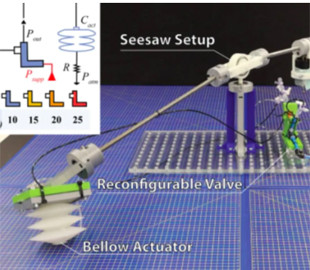
A team of scientists has developed a reversible circuit with an adjustable valve that uses pressure signals to control soft robots. This reduces the burden on the software.
Researchers at King's College London (KCL) have developed a new kind of tiny circuit that interacts with changes in fluid pressure, taking inspiration from how the human body works. Interesting Engineering writes about it.
Engineers have developed an improved method of transmitting complex instructions to robots without the use of electricity. This can potentially free up more processing space in the robot system for advanced features.
Researchers at King's College London (KCL) have developed a new kind of tiny circuit that interacts with changes in fluid pressure, taking inspiration from how the human body works. This method allows robots to perform tasks independently of conventional electrical systems by transmitting a series of commands using a fluid inside the circuit.
According to a statement from the team, this opens up the possibility of a new generation of robots whose bodies could operate independently of their built-in control center, potentially using that space instead for more complex software on the base, for the first time in the world.
Known for their flexibility and safety, soft robots have become useful in various applications such as wearable devices and manipulators. Typically, these robots are controlled by traditional systems using solenoid valves, regulators and pumps, which limits their mobility and miniaturization.
200% Deposit Bonus up to €3,000 180% First Deposit Bonus up to $20,000To solve this problem, scientists are studying new designs of soft valves and pumps that can be integrated into the body of the robot, increasing efficiency and allowing them to be used in harsh environments. These soft valves, which control fluid flow by bending tubes, reduce the need for multiple control inlets.
Some designs can remember or forget previous states, while others can create oscillators that work like clockwork, enabling robots to perform tasks such as swimming and climbing. However, some approaches still require multiple valves and additional pressure controls to fine-tune their operation.
Currently, robots are completely dependent on electricity and computer chips to operate. A robotic “brain”, consisting of algorithms and software, broadcasts commands to the robot's body through encoders, which then perform actions.
In soft robotics, where devices such as robotic muscles are made of flexible materials, this reliance on rigid electronic components creates problems. Complex tasks, such as grasping a doorknob, place additional strain on the software because soft materials require complex coding.
To solve this problem, the scientists created a reversible circuit that incorporates an adjustable valve into the robot's hardware . This valve uses pressure signals that look like binary code to control movements, much like a transistor in conventional circuits.
The technology also has the potential to improve soft robotics by overcoming current limitations in dexterity. One robot can work differently by reconfiguring its main element, a valve that changes the frequency of the signal, without changing any of the circuit components. The goal is to extend this capability by enabling robots to perform various tasks without modifying actuators or circuitry, saving roboticists time and energy.
The team's goal — scale your invention for wider use by integrating these circuits into drive-wheel systems with soft motors or robots that control power plants.

